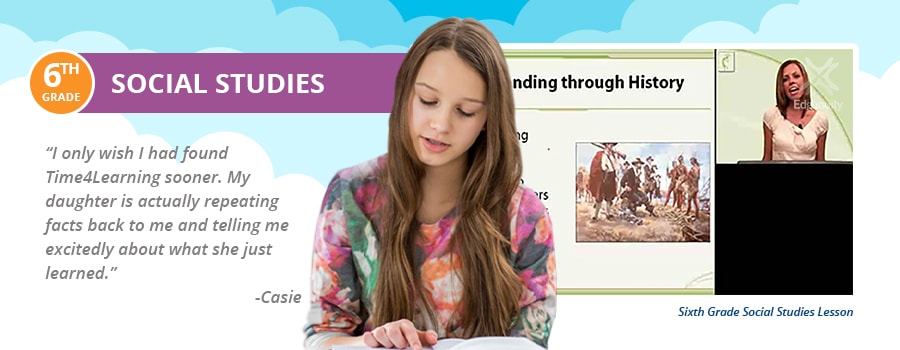Sixth Grade Social Studies Curriculum
During this year, students will take a close look at past civilizations and peoples, how they lived and interacted, and how different periods in history affected progress. In addition, students will take part in sixth grade social studies activities in reading and writing to develop their literacy skills even further.
This page includes information on teaching sixth grade social studies, objectives for the year, how Time4Learning’s social studies curriculum can help your child achieve those, and more.
What do You Teach in Sixth Grade Social Studies?
Sixth grade social studies typically focuses on the study of ancient world cultures. Time4Learning offers the following course for homeschoolers.
By default, our program auto-assigns the ancient world history curriculum to 6th graders. However, parents have the ability to change it. To learn more about what is covered in the course, click the link above.
Learn more about Time4Learning’s sixth grade social studies curriculum by checking out our sixth grade social studies lesson plans.
Social Studies Objectives for Sixth Grade
By the end of your child’s sixth grade year, they should be well-versed in a number of concepts and have achieved a number of 6th grade social studies objectives, including:
- Analyze historical migration patterns of early peoples
- Describe the structure of ancient Egyptian society
- Describe the innovations of ancient Chinese civilizations
- Explain the influence of ancient Greece on today’s literature and language
- Explain how society was organized in the Roman Empire
Time4Learning’s 6th Grade Social Studies Lesson Plan
Explain the origins of Judaism as the first religion based on the concept of one god. Analyze the significance of monotheism and the concept of moral laws for humanity. Discuss the Hebrew Bible as the source of the teachings and central beliefs of Judaism. Explain the role of beliefs such as the observance of law and the concepts of righteousness and justice. Discuss how the ideas of the Hebrews are reflected in the moral and ethical traditions of Western civilization.
Chapter Test: Ancient Hebrew Civilization
Describe the physical setting and location of the river system that supported the ancient civilization of the Indus River Valley. Describe the significance of the Aryan invasions of the Indus civilization.
Investigate the major beliefs and practices of Brahmanism in India and how they grew into Hinduism.
Investigate the social structure of the caste system.
Summarize the life and moral teachings of Buddha. Describe how Buddhism spread in India, Ceylon, and Central Asia. Describe the growth of the Maurya Empire and Emperor Asoka”s political and moral achievements.
Identify important artistic and intellectual contributions of the civilizations of India, including Sanskrit literature (Bhagavad Gita), medicine, astronomy, and mathematics.
Chapter Test: Early Civilizations of India
Summarize the achievements of the emperor Shi Huangdi when unifying northern China under the Qin dynasty.
Examine the contributions of the Han dynasty that led to the development and expansion of the empire. Explain the significance and location of the “silk roads” of the Han and Roman empires.
Describe the reunification of China under the Tang dynasty. Examine the reasons for the spread of Buddhism in China, Korea, and Japan during Tang China. Describe the agricultural, technological, and commercial developments during the Tang and Sung periods.
Examine the historical influence of Chinese discoveries such as tea, the manufacture of paper, the compass, woodblock printing, and gunpowder.
Chapter Test: Early Civilizations of China
Describe the location and rise of the Roman Republic. Investigate the following mythical and historical figures: Aeneas, Romulus and Remus, Cincinnatus, Julius Caesar, and Cicero.
Explain significant features of the government of the Roman Republic: written constitution, tripartite government, checks and balances, and civic duty.
Describe the political and geographic reasons for the growth of the Roman territories and empire, including the use of currency and trade routes. Describe the roles of Julius Caesar and Augustus Caesar in Rome’s transition from republic to empire.
Describe the migration of Jews in the Mediterranean region and their conflicts with the Romans.
Summarize the origins of Christianity in Jewish prophecies, the life and teachings of Jesus of Nazareth, and the contribution of St. Paul the Apostle to the spread of Christian beliefs.
Describe how Christianity spread in Europe and other Roman territories.
Explain the legacy of Roman art and architecture, technology and science, literature, language, and law.
Describe the climate and physical features of the Arabian Peninsula and its surroundings.
Explain the spread of Muslim rule by military conquest and treaties. Discuss the blending of cultures in the civilization and the acceptance of Islam and Arabic
Students will add and subtract using integers.
Identify the contributions that Muslim scholars made to later civilizations in science, geography, mathematics, philogosphy, medicine, art, and literature.
Chapter Test: Civilizations of Islam
Locate the Niger River and the vegetation zones of forest, savanna, and desert. Relate these features to the trade in gold, salt, food, and slaves, as well as to the growth of the Ghananian and Malian empires.
Describe the caravan trade across the Sahara and its role in changing religious and cultural characteristics of West Africa.
Summarize the importance of written and oral traditions in African history and culture.
Chapter Test: African Civilization
Describe the role of mining and the transcontinental railroad in the development of the West.
Identify the Native American nations that lived on the Great Plains. Describe the culture of the Plains Indians.
Explain why wars broke out between settlers and Native Americans. Name the battles that took place on the plains. Describe how the government ended wars.
Describe how cattle ranching became a big business. Describe how farmers adapted to life on the plains.
Explain why farmers faced hard times in the late 1800s. Discuss how farmers organized to help themselves.
Chapter Test: Settling the Western U.S.
Explain why railroads grew after the Civil War. Describe their impact.
Explain how steel became a big industry. Describe how business leaders helped build American industry. Explain why some people criticized big business.
Describe how the telephone was invented. Name the discoveries and inventions of Thomas Alva Edison. Explain how Henry Ford created a new way to make cars.
Describe how factory work changed in the 1880s. Describe how workers tried to improve their lives. Explain why violence broke out between workers and owners.
Students will show equivalent forms of percents in fractions and decimals and solve problems that are greater than 100%.
Chapter Test: Industrial Revolution
Explain why and how millions of people immigrated to America. Discuss how native-born Americans reacted to the newcomers.
Explain the growth of American cities. Identify the different populations that lived in the cities. Describe attempts at urban improvement.
Describe how cities changed in the late 1800s. Name the sports that Americans enjoyed. Describe how music influenced American life.
Chapter Test: Immigration to America
Describe how women won the right to vote and gained other opportunities. Describe the role of women in bringing about Prohibition.
Describe how Theodore Roosevelt became president. Identify the reforms that Roosevelt supported. Discuss Woodrow Wilson’s policies as president.
Describe how life for African Americans worsened in the 1890s. Discuss how African-American leaders fought discrimination. Identify the problems faced by African, Asian, Mexican, and Native Americans.
Chapter Test: United States 1877-1914
Explain why some Americans called for overseas expansion in the late 1800s. Describe how the United States gained Alaska. Explain how the United States increased its influence in the Pacific.
Explain the importance of Latin America to the United States. Identify the causes of the Spanish-American War, and explain why American opinion was divided regarding the peace treaty.
Describe how the United States built the Panama Canal.
Discuss the policies of the United States toward Latin America. Explain why the United States invaded Mexico in 1916.
Chapter Test: The U.S. as a World Power
Describe Native American artifacts that have been found in your state, and write an essay describing these peoples’ lives.
Conduct research to determine which type or types of Native American homes were used in your state. Include a detailed description of each type.
Identify your state’s major officeholders, such as governor, lieutenant governor, state senators, and local representatives. Write your local representative a letter that expresses your views on a current local or state issue.
Create a chart depicting the branches of your local community government. Include the names of current officeholders.
Chapter Test: Investigate Your State
Collect postcards and travel information depicting national and state landmarks in your state. Write to tourism boards, or research online sources, for information on the landmarks. Use this information to create your own travel brochure that encourages others to visit your favorite landmark.
Investigate the major industries of your state. Explain how these industries may be related to the availability of natural resources. Identify key people who were instrumental in the formation of each industry.
Chapter Test: Characteristics of Your State
Identify the advantages and disadvantages of globes and maps.
Locate the North and South Poles in relationship to the Arctic and Antarctic Circle.
Examine weather patterns in relation to the formation of desert ecosystems of the Middle East.
Chapter Test: Maps/Globes/Geographic Tools
Describe a citizen as defined in the Constitution, and explain how Americans are citizens of both their state and the United States. Describe the three ways to become a citizen of the United States.
Identify values and principles Americans share, as set forth in such documents as the Declaration of Independence and the United States Constitution. Explain why it is important to the guarantee of human rights that Americans understand and act on their shared political values and principles.
Differentiate between private life and civic life. Create a plan for participating in civic life.
Chapter Test: Political Science
Describe what a political party is and what it means to be a party member. Examine the functions performed by political parties, and explain how they are organized.
Explain how presidential candidates are selected. Summarize the presidential election from nominating conventions to general elections.
Chapter Test: U.S. Political System
Explain how physical geography, specialization, and trade influence the way people earn income. Explain how increased specialization and trade make countries wealthier yet more interdependent. Explain why international trade requires a system for exchanging money between and among nations.
Explain how economic decisions are made in a market economy by describing the relationships among economic factors (such as scarcity, choice, opportunity cost, money, goods and services, price, and supply and demand).
Describe different economic systems: traditional, command, and market. Compare how each system determines what will be produced, for whom, and how production will be accomplished.
Define gross domestic product (GDP). Compare and contrast the level and sources of GDP in countries of the Eastern world and the United States.
Chapter Test: U.S. Political System
Scope & Sequence Copyright © 2024 Edgenuity, Inc. All rights reserved.
Why Choose Time4Learning’s Sixth Grade Social Studies Homeschool Curriculum
Time4Learning’s 6th grade social studies curriculum helps students understand how ancient peoples and past events helped shape the world they live in. Students will explore various ancient civilizations throughout various parts of the world including Greece, China, and Rome.
The interactive 6th grade social studies curriculum will also help students build their reading and writing skills as well as develop their historical inquiry skills so that they are able to analyze information, interpret maps, make comparisons, and more.
Learn more about our online sixth grade curriculum, designed to help your child learn and master their fundamental concepts.







